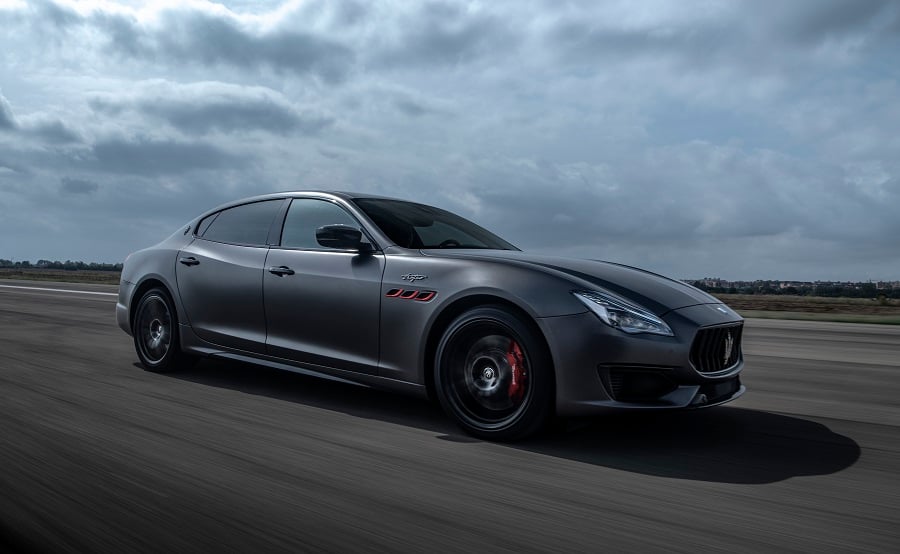A four-door luxury sports sedan now in its sixth generation, the Maserati Quattroporte is essentially a track-bred engine lavishly wrapped in opulence. What else can we expect from the chaps in Italy’s Modena?
Racing heritage to luxury production
Bindo, Alfieri, Ettore and Ernesto. Four of the six Maserati boys were hands-on mechanics and pivotal in the development of the brand in the early 20th century. A fifth brother, Mario, designed the Trident logo that is now recognized worldwide as synonymous with the luxurious style and peak performance that Maserati represents.
From the inception of the company in 1914, the Maserati brothers wanted to build track cars for racing. After initially producing parts for other manufacturers, one of the first Maserati’s ever built was driven by Alfieri Maserati and won the 1926 Targa Florio, a public road endurance race held in the mountains of Sicily.
However, tragedy struck in 1927 when Alfieri lost control of his Type 26 and was gravely injured at the Coppa Messina. Alfieri lost function of one of his kidneys among a host of other injuries but returned to racing. Over the next five years he would race and have multiple minor operations in the off seasons, but a botched attempt on his remaining kidney proved his undoing. In 1932, he unexpectedly died of complications at the age of 44.
By 1937, the remaining brothers, while dedicated to engineering works, felt lost without their entrepreneur leader and choose to sell their shares to Adolfo Orsi. The Maseratis were excellent mechanics and only wanted to concentrate on design and manufacturing while leaving the business side to Orsi. The entire enterprise moved from Bologna to Modena and racing success continued with four back-to-back wins of the Targa Florio.
Even during World War II, when the factory concentrated on the war effort, the Maserati brothers continued to design future models. Orsi, always the astute businessman, guided the brothers away from the racetrack. In 1947 the Maserati A6 grand tourer became the company’s first-ever production road car. Originally designed back in 1941, the straight-six engine was given the “A” designation in memory of Alfieri Maserati.

Power with elegance
Having only produced racetrack cars in their early history, the foray into the sports sedan was made in 1963. The first-ever “Quattroporte,” literally four doors in Italian, boasted a powerful 4.1-liter V-8 engine with a top speed of 143 Mph and was adorned with all the luxuries of its time. The target market then, as it is now, comprised wealthy owners who preferred understated fine lines with uncompromised peak performance.
Read: Ford returns to Formula 1
Performance focus
The new Quattroporte comes in three trim levels. The GT, the Modena (also available in Q4 version), and the Trofeo. The model we tested, the Modena Q4, would be considered the middle range option. Like all Quattroporte models that preceded it, as expected the current iterations expertly combine elegant design lines with sporty performance.
Under the hood is a twin-turbo direct-injection V6 producing 430-horsepower that will get you to 100 km/h in 4.8 seconds with a top speed of 288 km/h. The Trofeo trim, the more performance-focused package with its 3.8L V8, will knock off another 0.3 seconds and get you there in 4.5 seconds, maxing out at an absolutely absurd 326 km/h.

Understated luxury as standard
The outer lines haven’t changed much from the previous years because they frankly don’t need to. The long and slender body, coupled with the self-proclaimed shark-nose front, makes the Quattroporte look like it’s moving even while stationary. It’s evident, from just looking at it, that it’s a body built for performance but without the conspicuously showy excesses.
On the inside all the usual suspects are present. Soft and supple full grain leather, generous lashings of carbon fiber, and chrome accents finished to a high standard match the discreet and refined look showcased by Maserati. One slight niggle might be the blending of these very high-end materials with dashes of cheaper plastic. While not prevalent, they do take away from expectations at this price point.
A much-needed and welcome addition is the updated infotainment system. An Android Auto OS now runs on 10.1-inch HD touch-screen display in the mid-console and features a voice-activated virtual assistant. However, the presence of physical buttons for the essential controls is more important and celebrated, at least by this reviewer, more than any other feature in the cockpit. Well done, Maserati, for preventing any unintended taps and reducing the need for repetitive menu navigation during quick glances at the screen, simply to adjust the AC by half a degree.
Beauty with performance
The full motto of Maserati is “Beauty with Performance, Power with Elegance.” The Quattroporte embodies that maxim in many ways. While it may be argued that the Audi A-8 or the BMW 7-Series might pack more of a punch at this price point, they certainly don’t have the styling flair or exotic looks of the Quattroporte. Maserati owners have always been ones that want something different from the mainstream, something intangible. The new Quattroporte still has it.
For more on cars and boats, click here.








